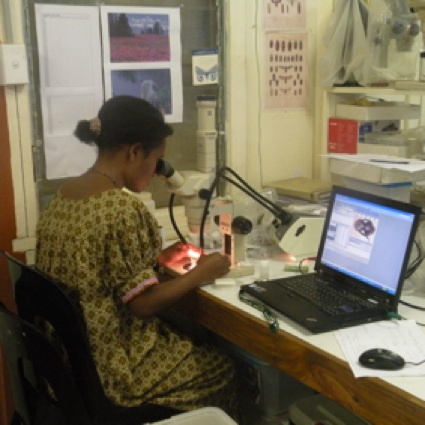This article is one from 15 different Papua New Guinean scientists taken from the manuscript of the new Grade 9 Science Outcomes textbook prior to the design and editing processes currently being undertaken at Pearson Education Australia. This is Francesca’s story. I hope all the parents, teachers and students reading this enjoy it. More scientists’ stories will appear here during the next few months.
This photograph is of Francesca busy in her laboratory identifying insects at the New Guinea Binatang Research Centre, in Madang.
Brian Robertson
Site owner
My name is Francesca Dem-Eric and I come from a small village called Guhi in the Kove area of West New Britain. I am married to a guy by the name of Eric from Madang. He is a parataxonomist working in the same organisation as I am. The New Guinea Binatang Research Centre is a non-government organization involved in research on the biodiversity of Papua New Guinea, particularly looking at the ecology of insects. It is also trains university biology students on how to do good scientific research and to know the importance of science.

There are four Masters students currently attached to the New Guinea Binatang Research Centre of which I am the only female. I am doing a project as part of my masters degree program, which looks at the “Community structure of Auchenorrhyncha (Insect: Hemiptera) along an altitudinal gradient in Papua New Guinea”. Auchenorrhyncha is a group of insects in the order Hemiptera, commonly known as sap-sucking insects or leafhoppers. These insects feed by piercing through every plant part, including the leaves, stems and roots, and sucking on them. In my study, however, I only look at those sap-sucking insects that feed on the xylem and phloem tissues of the plant. Phloem- and xylem-feeders are very important in agriculture as most of them are considered agricultural pests. A good example is Cofana spectra which is a pest of sweet potato. Auchenorrhynchans not only damage plants by sucking, but also through the transmission of diseases from one plant to the other.
I use the sweeping method to collect insects. I established 8 sites at elevations starting from 200m all the way to 3700m above sea level (Brahman to Mt Wilhelm) at intervals of 500m. Auchenorrhyncha occurring from 0 to 2 m above the ground were sampled with a standardized sweep net. At each site, 20 sampling units consisting of 500 sweeps each were obtained. Leafhoppers from the samples were preserved in alcohol and then later identified to species level using the database. The community data will be analysed using modern statistical methods, including multivariate analysis and analysis of beta and alpha diversity.
Science is very fascinating and challenging at the same time. What really excites me about science, particularly the field I am in, is that because you can’t communicate directly with the insects you must make very good observations and do sampling many times. You have to think biologically to try to understand how this particular species of animal and how it interacts with its conspecific (others of the same species) and/or other species in terms of food, shelter, territory, mating and defense in order to survive and continue its generation. Regarding my present study, what really interests me is that since it is the first of its kind carried out in PNG, it is very important as it will provide a baseline of information in helping to monitor many aspects of the environment in the future including climate change.
Carrying out studies on insects (binatang) is very important as pollination of flowers from plants is mostly done by insects and so by studying insects and knowing better what plant specie is fed on by which insect species, we will be more able to manage our forests well. This is important because once the forests are destroyed and gone, the insects will also disappear, and as a result we will loose our natural forests and biodiversity. In addition, studying insects will also help us to identify pathogens and vectors of cash crops and food crops in order to control the spread of them.
After I complete my current study, I plan to continue with a PhD and then look forward to working in either a government research body such as the Forest Research Institute or the Institute of Medical Research or work with the Department of Environment and Conservation. Or perhaps I will continue doing scientific research as a career and be part of the global scientific community.
Science has always been my favourite subject since starting school. While doing my undergraduate studies at the University of Papua New Guinea, majoring in biochemistry, I attended two biology field training courses as part of my assessment and found it very interesting and challenging, and so after I completed my bachelors degree I applied for studentship at the New Guinea Binatang Research Centre and was awarded a two year honours degree studentship. According to my performance and my interest in science, I decided to continue with a Masters degree and so currently I am undertaking this program, which will last for two years. My biggest motivation along the way is the fact that that out of every 200 plus university graduate science students, only 5 decide to continue their career in this field. Our government does not realize the importance of research-based science on the country’s biodiversity and so as a Papua New Guinean, I feel that I must contribute at least some information so that Papua New Guinea can continue to be recognized as one of the biodiversity hotspots in the world.
Francesca Dem-Eric